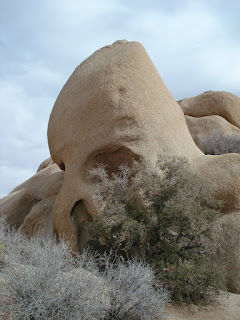Joshua Tree National Park
The higher, drier, and slightly cooler Mojave Desert is the special habitat of the Joshua tree from which the park gets its name. In addition to Joshua tree forests, the western part of the park includes some of the most interesting geologic displays found in California's deserts. The dominant geologic features of this landscape are hills of bare rock, usually broken up into loose boulders. These hills are popular amongst rock climbing and scrambling enthusiasts. The flatland between these hills is sparsely forested with Joshua trees. Together with the boulder piles and Skull Rock, the trees make the landscape otherworldly. Five Washingtonian fan palm oases in the park are the few areas where water occurs naturally and wildlife abounds.

The name Joshua tree was given by a group of Mormon settlers who crossed the Mojave Desert in the mid-19th century. The tree's unique shape reminded them of a Biblical story in which Joshua reaches his hands up to the sky in prayer. Ranchers and miners who were contemporary with the Mormon immigrants also took advantage of the Joshua tree, using the trunks and branches as fencing and for fuel for ore-processing steam engines.


Skull Rock


We had to move this boulder to get to the rest of the trail.


Cholla (Choy -a) Cactus
 The small round cactus pieces you see on the ground, are called jumping teddy bears. These Cholla cactus seeds, they fall to the ground and are moved by wind or animals till they take root.
The small round cactus pieces you see on the ground, are called jumping teddy bears. These Cholla cactus seeds, they fall to the ground and are moved by wind or animals till they take root.

Ocotillo
The ocotillo is a curious and unique desert plant of the southwestern United States and northern Mexico. For much of the year, the plant appears to be an arrangement of large spiny dead sticks, although closer examination reveals that the stems are partly green. With rainfall the plant quickly becomes lush with small ovate leaves, which may remain for weeks or even months.

Our Google Map Location












Glad you guys were able to make it to Joshua Tree! I had no idea about the history of the those silly looking trees! Thanks for the history lesson!
ReplyDelete